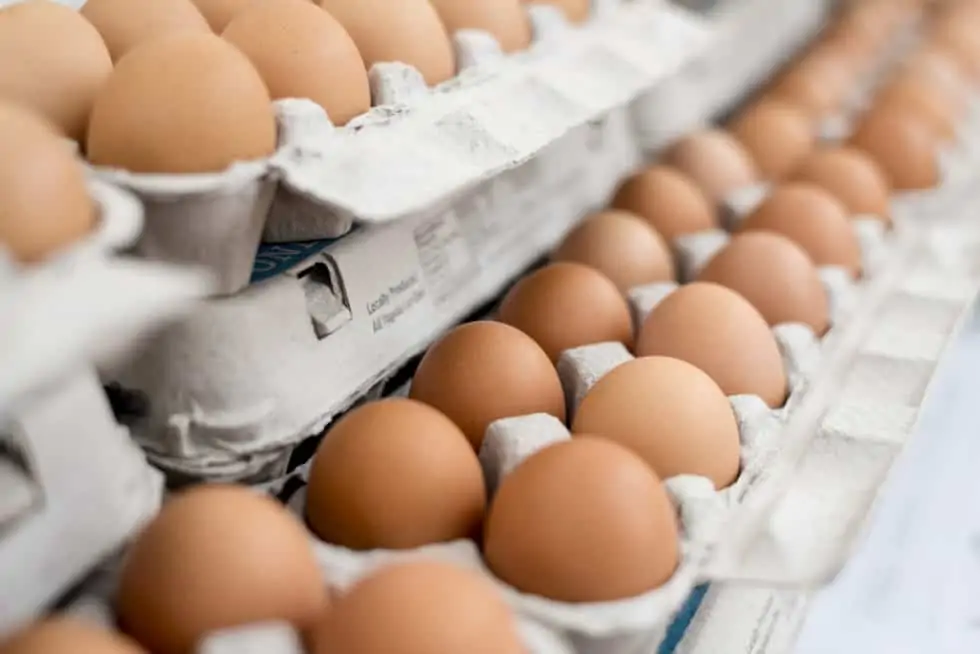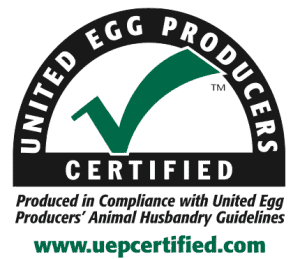
- The UEP Certified guidelines allow continuous confinement in crowded cages in dimly lit buildings without natural light and fresh air. Hens only have to be given enough space to stand upright, with a minimum space requirement of 8 by 8 inches for white laying hens kept in a cage. Producers keeping their hens in cages do not have to allow the hens to move freely, perch, dust bathe, or forage, and nest boxes are not required. While the label is verified, it is not meaningful as an animal welfare label because certain basic conditions, such as the freedom to move, are not required.
Is the label verified?
Yes
Is the meaning of the label consistent?
No
Are the label standards publicly available?
Partially
Is information about the organization publicly available?
No
Is the organization free from conflict of interest?
Partially
Was the label developed with broad public and industry input?
No
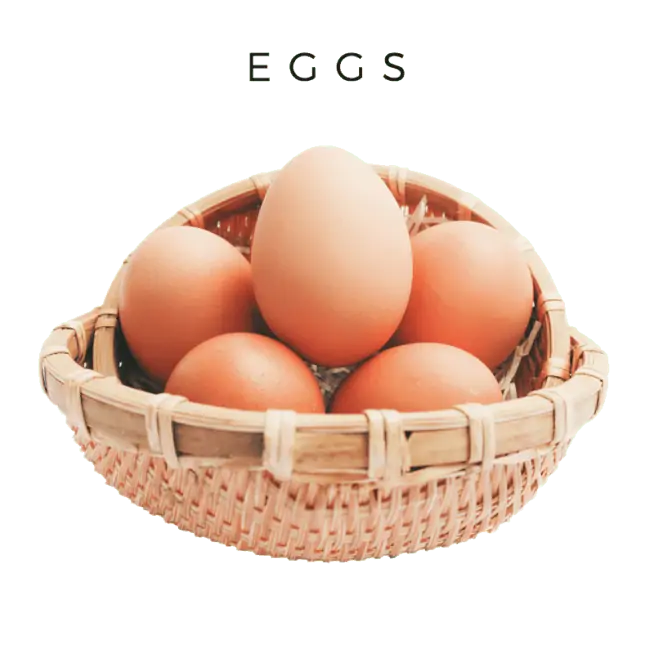
This label can be found on: Eggs
ORGANIZATION: United Egg Producers
url: http://uepcertified.com
LABEL STANDARDS: http://uepcertified.com/wp-content/uploads/2015/08/2016-UEP-Animal-Welfare-Guidelines-2016-Cage-Free-Edit-002.pdf
What this label means
The United Egg Producers (UEP) Certified label means that the producers met most of the requirements in a set of standards developed by the United Egg Producers, a cooperative trade group for egg producers.
The group writes that the UEP Certified program “was developed as an animal welfare program to improve the well-being of egg-laying hens and to meet the expectations of our customers.”
However, the UEP Certified guidelines allow continuous confinement in crowded cages in dimly lit buildings without natural light and fresh air.
Hens only have to be given enough space to stand upright, with a minimum space requirement of slightly over 8 by 8 inches for white laying hens kept in a cage. Producers do not have to allow the hens to move freely, perch, dust bathe, or forage, and nest boxes are not required for caged hens.
According to the United Egg Producers, approximately 76% of all eggs produced in the United States are produced under UEP Certified guidelines.
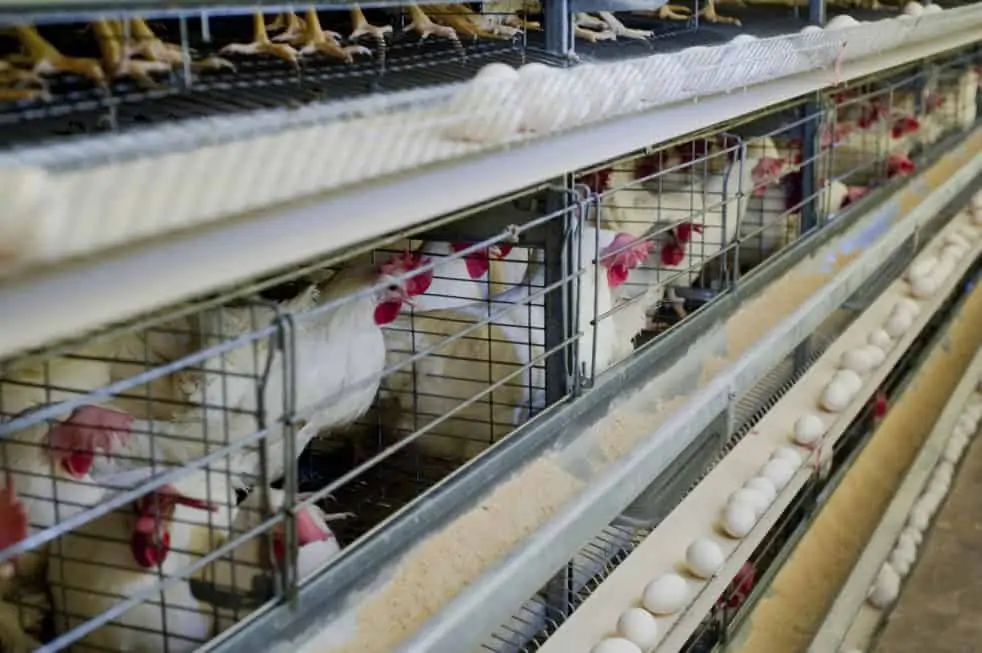
A closer look at the standards for laying hens
Cages
The standards allow the use of cages. The standards do not require that birds are able to move around freely or have enough space to fly, walk, and stretch their wings.
Indoor space per bird
Laying hens in cages have a minimum area of 8.2 by 8.2 inches (67 square inches), which is less than the size of a sheet of paper.
Laying hens in cage-free, multi-tier aviary houses have a minimum of 12 by 12 inches of floor space (1 square foot), and hens housed in a single-level all-litter house have a minimum of 14.5 by 15 inches of floor space (1.5 square feet).
Clean litter
There are no requirements for providing clean litter to hens in cages, nor areas for scratching or dust bathing, which means the hens do not have the opportunity to engage in these natural behaviors.
In cage-free houses, at least 15% of the useable floor area has to be a scratch area, covered with litter. The litter must be maintained in loose, friable condition.
Perches
Perches are not required in caged houses. In cage-free houses, perches are required and must provide at least 2 inches of perch space per bird until January 1, 2018, when the requirement increases to 4 inches per bird. After January 1, 2020, it increases to 6 inches per bird.
Indoor air / Ammonia levels
The guidelines state that ammonia concentrations should ideally be less than 10 ppm and should rarely exceed 25 ppm. This guideline is worth 5 points in the audit checklist, so it is not a requirement that has to be met (producers need a score of 180 out of 200 to pass).
Ammonia in the air is caused by the buildup of feces and urine. Ammonia is a colorless gas with a penetrating and pungent odor, and humans can smell ammonia when levels are above 5 ppm. Some studies suggest 25 ppm could have detrimental health effects to the animals, including irritating the membranes of the lungs and eyes.
Lighting
There are no requirements for a minimum period of continuous darkness at night, and no requirements for natural light to enter the houses. At least 0.5 foot candles of light intensity are required, but these levels are very low and only worth 5 points on the audit so it is not a requirement.
Indoor environmental enrichment
The standards do not require the provision of environmental enrichment for hens.
Indoor environmental enrichment are materials such as straw or hay bales that add complexity to the environment, encourage the expression of natural behavior, and decrease the expression of abnormal and deleterious behavior.
Outdoor access
There is no requirement for outdoor access. Hens can be continually confined in cages or indoors in cage-free houses.
Beak trimming
The standards allow beak trimming, which must be done before the chicks are 10 days old with a precision automated beak trimmer.
However, a second trim is allowed until the chickens are 8 weeks old (full-grown).
Beak trimming is a common practice to prevent aggressive behavior and feather pecking, which can happen when chickens are closely confined in crowded spaces and are not given the opportunity to engage in their natural “scratching-and-pecking” behaviors.

A closer look at the standards for:
Antibiotic use
The UEP Certified guidelines do not prohibit the use of antibiotics.
To protect public health and combat the global threat of antibiotic resistance, antibiotics should only be used to treat diagnosed disease in animal agriculture. It is the industry norm to use antibiotics for disease prevention and control as well as for disease treatment. Choosing animal products from animals raised without antibiotics is an important step consumers can take to help address the public health crisis of antibiotic resistance.
Drugs for growth promotion
Hormones are not allowed and are not used in egg production.
Animal by-products in feed
The UEP Certified guidelines do not prohibit animal by-products in feed.
In poultry feed, the FDA does not restrict the use of slaughterhouse waste products and waste from livestock operations, such as poultry litter and feces.
GMOs in feed
The UEP Certified guidelines do not prohibit GMOs in animal feed.
CONSUMER REPORTS EVALUATION
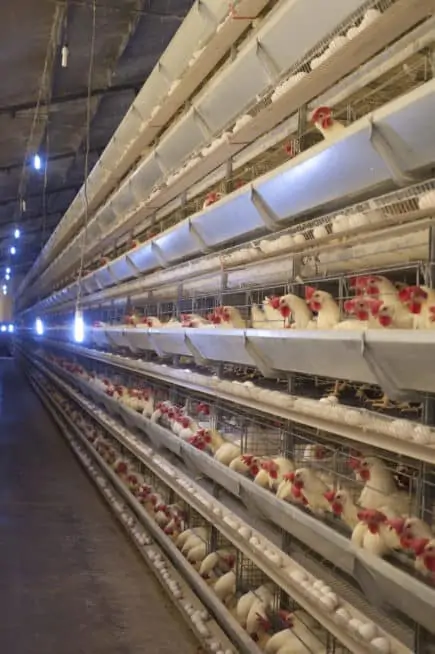
How meaningful is this label?
The UEP Certified label is not meaningful as an animal welfare label. Eggs with the UEP Certified label can come from hens that were kept in crowded cages, without enough space to move (only enough space to “stand upright” is required), in dimly lit buildings that are not required to have fresh air.
MORE:
The UEP Certified label represents the industry norm for raising laying hens and producing eggs, which is to house hens in densely packed cages.
The standards require a minimum of 67 square inches of space per bird, which is less than the size of a sheet of paper. Other practices that are allowed include beak trimming, and living conditions with noticeable ammonia in the air due to the buildup of manure.
In cage-free houses, hens can be raised in a barren environment without the opportunity to move freely or engage in natural behaviors such as scratching, dust bathing, or foraging.
The United Egg Producers claims that its guidelines aim to “improve the welfare of laying hens” and are “science-based recommendations for keeping laying hens humanely.” The UEP also specifically claims that modern cage systems improve animal welfare.
However, in our 2016 consumer survey, we found that 66% of consumers expect a “humanely raised” claim on eggs should mean that animals are raised without cages. A majority of consumers also think that “humanely raised” animals should have adequate living space (86%), be able to go outdoors (78%) and be raised in houses with clean air (78%). The UEP Certified label does not meet consumers’ expectations in each of these areas.
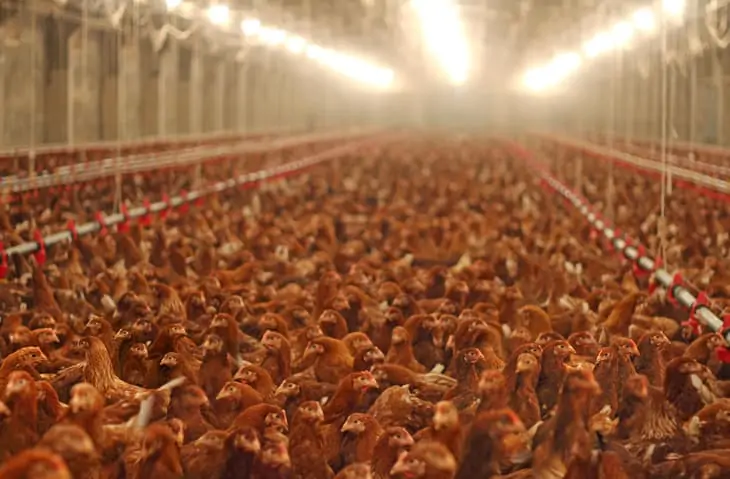
Is the label verified?
Yes. Producers are audited through on-site visits annually by either a private certification firm (Validus or FACTA) or the USDA’s Agricultural Marketing Service (AMS).
Is the meaning of the label consistent?
No.
While the auditors use the audit checklist developed by the United Egg Producers to ensure consistency, there are different audit checklists depending on the type of housing. Specifically, the UEP label can be found on eggs from either caged hens or uncaged hens, with a different set of standards for each system. It is likely that eggs from cage-free operations will be labeled as “cage-free” on the carton so consumers can know which set of standards was used, but there is no difference in the UEP Certified seal for caged and cage-free operations.
Producers do not need to meet all standards to be certified. Producers pass the audit and are certified if they score at least 180 of 200 points. Some of the requirements have to be met to be certified, regardless of the final score, including meeting the space requirements, not backfilling cages, not commingling certified and non-certified eggs, and not using feed withdrawal to induce the hens to molt. Other guidelines, including a ventilation system that allows for a continuous flow of fresh air, keeping ammonia levels in the air below a certain level, and handling the birds in a way that avoid bone breakage and injury, are worth 3 or 5 points each and therefore are not required for certification.
Are the label standards publicly available?
Partially.
While a document titled “Animal Husbandry Guidelines” is available on the UEP website, it does not state how many points each guideline is worth. Since producers need to score 180 out of 200 points, it is important to know the score assigned to each guideline. The checklist used by auditors, which shows the score assigned to each guideline, was shared with Consumer Reports but is not available publicly.
Is information about the organization publicly available?
United Egg Producers is a cooperative of egg farmers, who own approximately 95% of the nation’s egg-laying hens.
Board of directors: No. The members of the board of directors are not listed on the website. The board consists of 34 egg producers.
Financial information: No. Financial information is not available publicly.
Is the organization free from conflict of interest?
Partially.
Standards development: No. Thirty four members of the UEP board of directors are egg producers, and they make the final decision regarding the standards. The development of the standards is not free from conflict of interest.
Verification: Yes. The farms are audited by either a private certification agency (Validus or FACTA) or the USDA’s Agricultural Marketing Service. If the farm passes the audits, the UEP approves the company’s certification status.
Was the label developed with broad public and industry input?
No.
Standards development: No. A Scientific Advisory Committee, comprised of academics and veterinarians, developed scientific recommendations, which were shared with the UEP Animal Welfare Committee. The Animal Welfare Committee consists of egg producers and develops the final standards.
Standards updates: No. The standards are updated based only on recommendations by the Scientific Advisory Committee. There is no opportunity for public participation and input.
